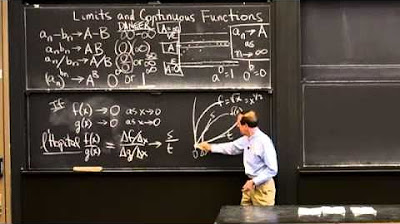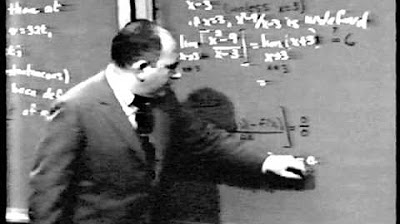Calculus Chapter 1 Lecture 7 Limits
TLDRIn this calculus lecture, Professor Greist delves into the concept of limits, a fundamental aspect of calculus. He explains the formal definition of a limit, contrasting it with the common intuition, and illustrates it with the ε-Δ (epsilon-delta) approach. The lecture also covers the limit's properties, such as continuity and the rules governing limit operations. Professor Greist emphasizes the power of Taylor series in computing limits, especially in indeterminate forms, providing clear examples and emphasizing the importance of understanding the 'why' behind computational methods.
Takeaways
- 📚 Calculus is fundamentally the study of limits, which are a central concept in the field.
- 🎯 The definition of a limit involves the concept of epsilon (ε) and delta (Δ), where for any ε > 0, there exists a Δ > 0 such that if the input is within Δ of 'a', the output is within ε of 'L'.
- 🔍 The limit definition is often visualized with the ε-Δ approach, where ε represents the acceptable error in the output and Δ in the input.
- 🤔 Understanding the limit definition can be challenging due to its complexity as a logical and grammatical statement.
- 🌌 Limits can also be considered in the context of infinity, where the concept of a neighborhood of infinity is introduced with a lower bound 'M'.
- 🚫 Not all limits exist; functions can have discontinuities, blow-ups, or oscillations that prevent the existence of a limit.
- 🔄 Continuity of a function at a point 'a' is defined by the existence of the limit as X approaches 'a' and its equality to the function's value at 'a'.
- 🔗 There are rules for limits, such as the summation, product, quotient, and composition rules, which help in evaluating complex limits.
- 📉 The limit of sine(X)/X as X approaches 0 is a classic example often memorized as 1, but can be understood through Taylor series.
- 🧩 Taylor series are a powerful tool for computing limits, especially in cases where the limit is not immediately obvious.
- 🔑 L'Hôpital's rule is mentioned as a method for evaluating limits of the form 0/0 or ∞/∞, but the script emphasizes the importance of understanding why it works.
- 🔮 The script concludes by emphasizing the difference between knowing how to compute a limit and truly understanding the concept of a limit.
Q & A
What is the main topic of lecture seven by Professor Greist?
-The main topic of lecture seven is limits, which are fundamental to the study of calculus.
What is the definition of a limit according to the script?
-The limit of a function f(x) as x approaches a is L if for every epsilon greater than 0, there exists a Delta greater than 0 such that whenever x is within Delta of a, then f(x) is within epsilon of L.
What does the script suggest about the relationship between the limit definition and the function's value at x equals a?
-The script suggests that the actual value of the function at x equals a does not matter for the definition of the limit; what matters is the behavior of the function as x approaches a.
How does the script describe the concept of epsilon and Delta in the context of limits?
-Epsilon represents the tolerance or acceptable error on the output, while Delta represents the tolerance on the input. For the limit to exist, any input within Delta of a must result in an output within epsilon of L.
What is the significance of the limit as x approaches infinity in the script?
-The limit as x approaches infinity is considered by treating infinity as an endpoint to the real line, and it requires that for any given output tolerance epsilon, there must be an input tolerance that ensures the output is within epsilon of L when x is sufficiently large.
What does the script say about the existence of limits for all functions?
-The script indicates that not all limits exist for all functions. There can be discontinuities, blow-ups, or oscillations that prevent a limit from existing at a certain point.
What is the definition of a continuous function according to the script?
-A function is continuous at an input a if the limit as x approaches a of the function exists and equals the function's value at a. A function is continuous everywhere if this is true for all inputs a in the domain.
What are some rules associated with limits mentioned in the script?
-The script mentions the summation rule, product rule, quotient rule, and chain rule for limits. These rules allow for the computation of limits of sums, products, quotients, and compositions of functions, respectively.
How does the script introduce the concept of using Taylor series to evaluate limits?
-The script introduces Taylor series as a method to evaluate limits by expanding functions into their series representation and then simplifying the expression to find the limit, especially in cases where direct substitution yields an indeterminate form.
What is an example of a limit evaluated using Taylor series mentioned in the script?
-An example given is the limit as x approaches 0 of sine of x over x, which is evaluated using the Taylor series expansion of sine x, resulting in a limit of 1.
What is the importance of understanding the concept of limits beyond just computation according to the script?
-The script emphasizes that understanding the concept of limits is crucial for a deeper comprehension of calculus, as it goes beyond mere computation and involves understanding the behavior of functions as they approach certain values.
Outlines
📚 Introduction to Limits in Calculus
Professor Greist begins lecture seven by defining calculus as the mathematics of limits. He explains the concept and definition of a limit, emphasizing the importance of understanding the limit as X approaches a value 'a' of a function 'f(X)' equals 'L'. The professor clarifies that the function's value at 'a' is irrelevant; what matters is the behavior as X approaches 'a'. He introduces the formal definition of a limit involving the concept of 'epsilon' and 'delta', which are used to describe the precision of the limit. The professor also discusses the intuition behind this definition, comparing it to hitting a target with a certain tolerance level, and explains how this definition can be extended to limits at infinity.
🔍 Continuity and Limit Rules
The second paragraph delves into the concept of continuity, explaining that a function is continuous at a point 'a' if the limit as X approaches 'a' of the function equals the function's value at 'a'. The professor mentions that most functions encountered are continuous and that the domain of the function must be clearly defined to understand discontinuities. He also outlines the rules associated with limits, such as the summation, product, and quotient rules, and the chain rule, noting the importance of these rules in computing limits effectively. The paragraph concludes with a mention of a quiz to test students' understanding of limits.
🧐 Applying Taylor Series to Compute Limits
In the third paragraph, the professor discusses the application of Taylor series to compute limits, especially in cases where direct evaluation is not possible due to indeterminate forms like 0/0. He uses the example of the limit of sine(X)/X as X approaches zero, demonstrating how the Taylor series expansion of sine(X) simplifies the problem and leads to the correct limit of one. The professor also addresses the limit of (1 - cos(X))/X, showing how the Taylor series can clarify the limit and eliminate the ambiguity of 0/0. He further illustrates the method with the example of the cube root of (1 + 4X) minus one over the fifth root of (1 + 3X) minus one, demonstrating how the binomial series can be used to find the limit when direct substitution is not feasible. The paragraph ends with a reflection on the importance of understanding the process of computing limits, rather than just memorizing results.
Mindmap
Keywords
💡Calculus
💡Limits
💡Taylor Series
💡Epsilon-Delta Definition
💡Continuity
💡Discontinuity
💡L'Hôpital's Rule
💡Binomial Series
💡Indeterminate Forms
💡Domain
💡Chain Rule
Highlights
Calculus defined as the mathematics of limits.
Review of the concept and definition of a limit.
Explanation of the limit as X approaches a of f(X) equals L.
Clarification that the limit does not depend on the function's value at x=a.
Introduction of the formal epsilon-delta definition of a limit.
Illustration of the epsilon-delta definition with a diagram.
Discussion on the flexibility in choosing Delta for the limit definition.
Extension of the limit concept to the case of X approaching infinity.
Explanation of how to handle limits at infinity using a lower bound M.
Potential issues with limits, such as discontinuities and oscillations.
Definition of a continuous function and its properties.
Rules for limits, including summation, product, quotient, and chain rules.
Special case handling when the denominator of a limit is zero.
Quiz question on the limit of sine(X)/X as X approaches zero.
Use of Taylor series to compute limits, especially in indeterminate forms.
Example of using Taylor series to find the limit of sine(X)/X as X approaches zero.
Application of Taylor series to compute the limit of (1 - cos(X))/X as X approaches zero.
Complex example of using Taylor series for the cube root and fifth root functions.
The importance of understanding the concept of a limit beyond computation.
预告下一课将讨论 l'Hôpital 法则作为评估极限的主要工具。
Transcripts
Browse More Related Video

Limits and Continuous Functions

Calculus Chapter 1 Lecture 8 l'Hopital's Rule

Calculus Chapter 3 Lecture 25 Definite Integrals

Unit I: Lec 4 | MIT Calculus Revisited: Single Variable Calculus

Limits, L'Hôpital's rule, and epsilon delta definitions | Chapter 7, Essence of calculus

Epsilon-delta definition of limits
5.0 / 5 (0 votes)
Thanks for rating: